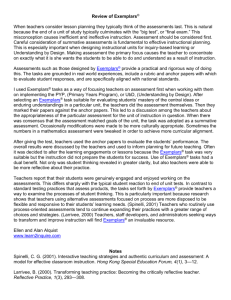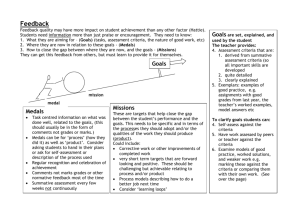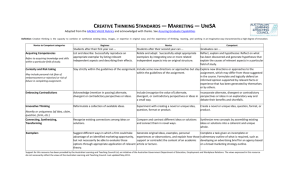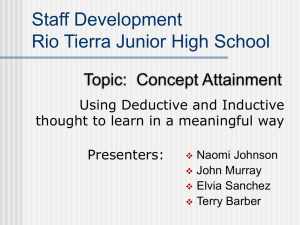mapping animals
advertisement
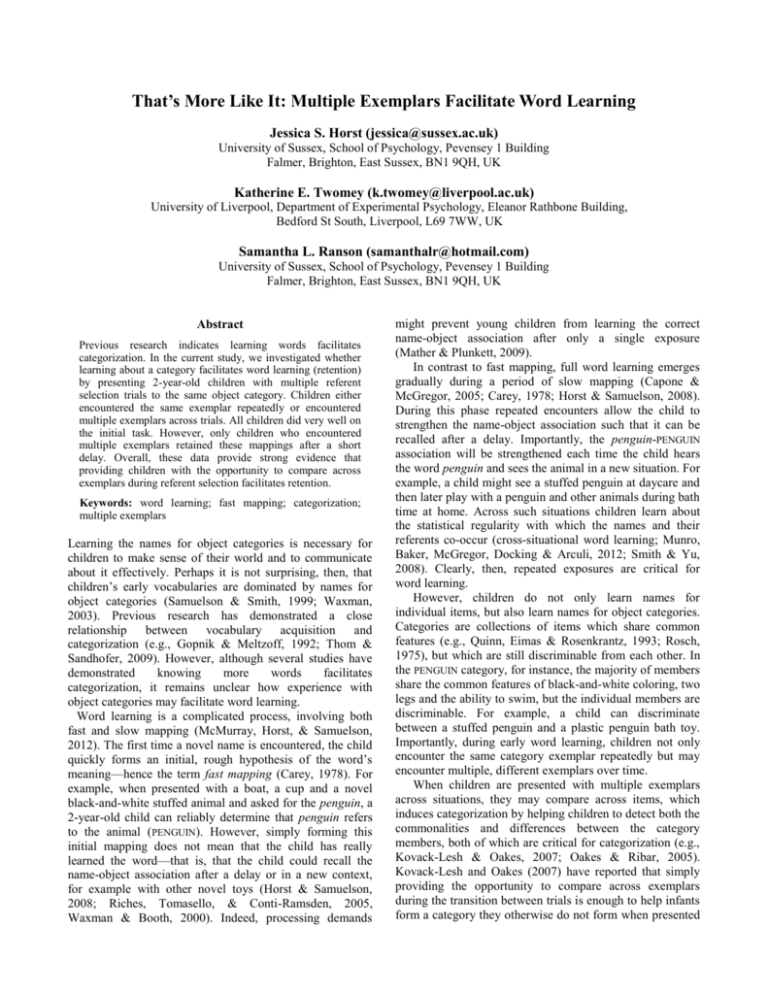
That’s More Like It: Multiple Exemplars Facilitate Word Learning Jessica S. Horst (jessica@sussex.ac.uk) University of Sussex, School of Psychology, Pevensey 1 Building Falmer, Brighton, East Sussex, BN1 9QH, UK Katherine E. Twomey (k.twomey@liverpool.ac.uk) University of Liverpool, Department of Experimental Psychology, Eleanor Rathbone Building, Bedford St South, Liverpool, L69 7WW, UK Samantha L. Ranson (samanthalr@hotmail.com) University of Sussex, School of Psychology, Pevensey 1 Building Falmer, Brighton, East Sussex, BN1 9QH, UK Abstract Previous research indicates learning words facilitates categorization. In the current study, we investigated whether learning about a category facilitates word learning (retention) by presenting 2-year-old children with multiple referent selection trials to the same object category. Children either encountered the same exemplar repeatedly or encountered multiple exemplars across trials. All children did very well on the initial task. However, only children who encountered multiple exemplars retained these mappings after a short delay. Overall, these data provide strong evidence that providing children with the opportunity to compare across exemplars during referent selection facilitates retention. Keywords: word learning; fast mapping; categorization; multiple exemplars Learning the names for object categories is necessary for children to make sense of their world and to communicate about it effectively. Perhaps it is not surprising, then, that children’s early vocabularies are dominated by names for object categories (Samuelson & Smith, 1999; Waxman, 2003). Previous research has demonstrated a close relationship between vocabulary acquisition and categorization (e.g., Gopnik & Meltzoff, 1992; Thom & Sandhofer, 2009). However, although several studies have demonstrated knowing more words facilitates categorization, it remains unclear how experience with object categories may facilitate word learning. Word learning is a complicated process, involving both fast and slow mapping (McMurray, Horst, & Samuelson, 2012). The first time a novel name is encountered, the child quickly forms an initial, rough hypothesis of the word’s meaning—hence the term fast mapping (Carey, 1978). For example, when presented with a boat, a cup and a novel black-and-white stuffed animal and asked for the penguin, a 2-year-old child can reliably determine that penguin refers to the animal (PENGUIN). However, simply forming this initial mapping does not mean that the child has really learned the word—that is, that the child could recall the name-object association after a delay or in a new context, for example with other novel toys (Horst & Samuelson, 2008; Riches, Tomasello, & Conti-Ramsden, 2005, Waxman & Booth, 2000). Indeed, processing demands might prevent young children from learning the correct name-object association after only a single exposure (Mather & Plunkett, 2009). In contrast to fast mapping, full word learning emerges gradually during a period of slow mapping (Capone & McGregor, 2005; Carey, 1978; Horst & Samuelson, 2008). During this phase repeated encounters allow the child to strengthen the name-object association such that it can be recalled after a delay. Importantly, the penguin-PENGUIN association will be strengthened each time the child hears the word penguin and sees the animal in a new situation. For example, a child might see a stuffed penguin at daycare and then later play with a penguin and other animals during bath time at home. Across such situations children learn about the statistical regularity with which the names and their referents co-occur (cross-situational word learning; Munro, Baker, McGregor, Docking & Arculi, 2012; Smith & Yu, 2008). Clearly, then, repeated exposures are critical for word learning. However, children do not only learn names for individual items, but also learn names for object categories. Categories are collections of items which share common features (e.g., Quinn, Eimas & Rosenkrantz, 1993; Rosch, 1975), but which are still discriminable from each other. In the PENGUIN category, for instance, the majority of members share the common features of black-and-white coloring, two legs and the ability to swim, but the individual members are discriminable. For example, a child can discriminate between a stuffed penguin and a plastic penguin bath toy. Importantly, during early word learning, children not only encounter the same category exemplar repeatedly but may encounter multiple, different exemplars over time. When children are presented with multiple exemplars across situations, they may compare across items, which induces categorization by helping children to detect both the commonalities and differences between the category members, both of which are critical for categorization (e.g., Kovack-Lesh & Oakes, 2007; Oakes & Ribar, 2005). Kovack-Lesh and Oakes (2007) have reported that simply providing the opportunity to compare across exemplars during the transition between trials is enough to help infants form a category they otherwise do not form when presented with the same items in the same sequence. This is especially important because it demonstrates that young children are able to compare between exemplars across trials. Namy and Gentner (2002) as well as others (e.g., Casasola, Bhagwat, & Burke, 2009; Waxman, 2003) have previously argued that applying a common name to multiple exemplars invites children to compare across items and draws their attention to shared commonalities. For example, when two objects are given the same name, children will extend this common name to new objects that share the same perceptual features with the named exemplars (e.g., texture; Graham, Namy, Gentner & Meagher, 2010). Importantly, these findings demonstrate that exposing children to multiple, variable exemplars labeled with a common, novel name allows children to detect the similarities between objects and therefore facilitates categorization. However, it remains unclear whether comparison facilitates children’s ability to retain category names because the existing studies on the effect of presenting multiple category exemplars on word learning have focused largely on generalization. For example, in a longitudinal category training study, toddlers who encountered multiple perceptually variable exemplars experienced a significant acceleration in vocabulary growth and were able to generalize novel names to novel exemplars from the same categories, in contrast to children who encountered perceptually similar exemplars (Perry, Samuelson, Malloy, & Schiffer, 2010). The current study examines whether providing children with the opportunity to compare across exemplars facilitates their ability to learn and retain names for novel object categories. We tested 2-year-old children because they can complete multiple trials without becoming overly tired and enjoy this particular task. We provided children with multiple fast mapping by mutual exclusivity trials to better understand how encountering multiple exemplars facilitates cross-situational word learning. Further, while previous studies have investigated how encountering multiple exemplars effects children’s generalization of novel names, the current study explores the effect on retention. Children encountered each novel object category across three referent selection trials. Half of the children were repeatedly presented with the same exemplar across trials and half of the children were presented with multiple exemplars across trials. If providing the opportunity to compare across exemplars facilitates cross-situational word learning, then children who fast-mapped multiple exemplars should demonstrate better retention. enjoy selecting objects in this paradigm and can complete several 3-alternative forced-choice trials without becoming overly tired. Children were from predominantly middle class homes. Half of the children were randomly assigned to the single exemplars condition and the other half were randomly assigned to the multiple exemplars condition. Children’s ages and productive vocabularies did not differ between conditions. Data from two additional children were excluded from analyses due to fussiness and experimenter error. Parents were reimbursed for travel expenses and children received a small gift for participating. Stimuli Eighteen known objects, chosen because they are highly familiar to 2-year-old children, served as familiar objects: bird, chicken, elephant, fish, giraffe, lion, boat, bus, car, motorcycle, plane, train, block, chair, comb, cup, toy mobile phone and spoon. Nine novel objects from three categories, chosen because they are not easily named by 2-year-old children, served as the target objects (see Figure 1). Consistent with other studies (e.g., Vlach, Sandhofer & Kornell, 2008), the objects in these categories varied in color and texture, but shared the same shape. The doff category consisted of slightly transparent, plussign shaped tops in green, red and yellow. The cheem category consisted of plastic rods with small balls on one end in blue/orange, orange/blue and yellow/green. The hux category consisted of rubber balloons with elastic strings hanging down in blue/orange, green/white and yellow/blue. The balloons kept their shape because they had foam balls inside them. All objects were similar in size (5cm x 8cm x 10cm). Stimuli were presented on a white tray divided into three even sections. A digital kitchen timer was used to time the 5-minute break. Method Participants Twenty-four children aged 2;6 (13 girls, M = 2;6 SD = 43.19 days; range = 2;4 – 2;8) with a mean productive vocabulary of 563.75 words (SD = 81.91 words, range = 391 - 668 words) and no family history of colorblindness participated. We tested children in this age range because they tend to Figure 1: Novel stimuli Procedure and Design Before the experiment began, the experimenter showed the parent color photographs of the known and novel objects to ensure they were known and novel to the child, respectively (which they were for all children). During the experiment, children were seated in a booster seat at a white table across from the experimenter. Parents sat next to their children and completed a vocabulary checklist and were instructed to avoid interacting with their children, but to encourage them to respond during the warm-up trials if necessary. None of the children needed parental encouragement after the warm-up trials. Warm-up trials Each session began with three warm-up trials to introduce children to the task. On each trial, children were presented with three randomly selected known objects. First, the experimenter set the tray of objects on the table and silently counted for three seconds to give the child an opportunity to look at the objects (see also, Horst, Scott, & Pollard, 2010). Then, the experimenter asked the child to select an object by naming it twice (e.g., “Can you find the block? Can you get the block?”) before sliding the tray forward. Children were praised heavily for correct responses and corrected if necessary. Between trials the experimenter replaced the tray on her lap and arranged the objects for the next trial out of the child’s view. The same objects were presented on each warm-up trial, but object positions (left, middle, right) were pseudorandomized across trials. Thus, children were asked for a different object in a different position on each trial. Warmup stimuli were later used as known objects during the referent selection trials (see also, Horst & Samuelson, 2008). Referent Selection Task. Referent selection trials immediately followed the warm-up trials and proceeded in the same manner except that children were neither praised nor corrected. Each child was presented with nine sets and saw each set once on a known name referent selection trial and once on a novel name trial for a total of 18 referent selection trials (see Figure 2 for examples). Known name trials were included to ensure that children were mapping the names to the requested targets and not simply mapping novelty to novelty (Horst, Samuelson, Kucker & McMurray, 2011). Each set included two familiar objects (e.g., boat and cup) and one novel object (e.g., top). Children in the multiple exemplars condition saw a different novel exemplar in each set. For example, a child might see the green top with the block and lion, the red top with the chair and train and the yellow top with the bus and fish (see Figure 2). Children in the single exemplars condition saw the same exemplar in each set. For example, a child might see the green top with the block and lion, and again the chair and train and once more with the bus and fish. Thus, the only difference between conditions was whether children saw one or three exemplars from each category. Figure 2: Trials on which the doff was present Referent selection trials were presented in three blocks. For example, one child completed all trials with the doff category, then all trials with the cheem category and finally all trials with the hux category. Block order was counterbalanced across participants using a Latin Square design. The order of known and novel trials was pseudorandomized in each block such that the same set (e.g., green top, lion, block) was never presented on two consecutive trials and no more than two trials of either type (i.e., known or novel) were presented sequentially. Object position (left, middle, right) was randomly determined on each trial. Between the referent selection task and the retention task the child remained at the table and colored pictures during a five-minute delay period. This delay period was included to ensure that children’s retention was based on long-term memory representations for the novel name-object associations formed during the referent selection phase rather than short-term maintenance (for a similar argument see, Horst & Samuelson, 2008). Retention Task The retention task was the same in both conditions. First, to re-engage children in the task, a new warm-up trial with three different known objects was presented. This was immediately followed by three retention trials, during which children saw three novel exemplars: one from each novel category (top, rod, balloon). The same exemplars were presented on all trials for a given child. In the single exemplars condition, children were presented with the same exemplars encountered earlier. In the multiple exemplars condition, children were presented with one of the three exemplars encountered earlier, which each exemplar (e.g., green top) being presented equally often across children. Object positions were randomized across trials and children were asked for a different novel object in a different position on each trial. Coding. Children’s responses were coded offline from DVD. Responses included touching and picking up objects (see Horst et al., 2011, for a deeper discussion of possible responses on this type of task). A naïve coder coded 20% of the sessions for reliability. Inter-coder agreement was high, M = 98.08%, SD = 3.44% (range = 92.31% – 100.00%). Overall, 90% of the target words were included in the analyses of children’s retention as, like prior studies, only the words that a child correctly fast-mapped at least once during the referent selection trials were included in subsequent analyses. There was no evidence of group differences in interest/attention during the experiment. Results We first compare children’s performance to chance levels and then compare children’s performance between conditions. As can be clearly seen in the left panel of Figure 3 children in both conditions were very accurate at choosing the target object during the initial referent selection task. On known name referent selection trials, 11 children in each condition chose the target on every trial, and one child in each condition chose the target on 8/9 trials. Thus, children’s proportion of target choices was the same for both conditions and greater than would be expected by chance (.33), t(11) = 71.73, p < .0001, d = 20.60 (all ps are twotailed). On novel name referent selection trials, children’s proportion of target choices was also greater than expected by chance (.33) both for children in the multiple exemplars condition, t(11) = 6.57, p < .0001, d = 2.38 and for children in the single exemplars condition, t(11) = 4.59, p < .001, d = .84. Again, there was no difference between conditions, t(22) = 0.345, ns. Thus, whether children encountered multiple exemplars or the same exemplars repeatedly during referent selection did not influence children’s performance on either known or novel name referent selection trials. the multiple exemplars condition retained more names than expected by chance (.33), t(11) = 5.00, p < .001, d = 1.46. Children in the single exemplars condition failed to retain more words than expected by chance, t(11) = 1.47, ns, d = .44. An unpaired t-test confirmed that children who encountered multiple exemplars retained more words than children who encountered the same exemplars repeatedly, t(22) = 2.06, p ≤ .05, d = .16. To further understand how multiple exemplars influence children’s ability to retain newly fast-mapped names we also explored retention as a function of number of successful referent selection trials. As can be seen in Table 1, when children only successfully fast-mapped on one of the three trials, they were unable to retain that name over a five-minute delay, regardless of whether they saw the same or different exemplars on their two unsuccessful trials. When children successfully fast-mapped twice, they were able to retain that category name if they encountered multiple exemplars but not if they encountered the same exemplar repeatedly. Finally, when children successfully fast-mapped three times, they were able to retain that name whether they had mapped the name to multiple exemplars or to the same exemplar repeatedly. Taken together, these data confirm that multiple exemplars facilitate word learning via fast mapping and that sufficient encounters with the same exemplar can also lead to retention. Table 1: Number of words retained as a function of number of correct referent selection trials. N in parentheses. Exact binomial probabilities, *** p <.0001, ** p <.01, * p< .05. Correct Number of Trials per Word During Referent Selection One Trial Two Trials Three Trials Multiple Exemplars Single Exemplar 2 (6) 6 (9)* 15 (18)*** 1 (6) 3 (8) 11 (17)** Discussion Figure 3: Children’s proportion of correct choices. Dotted line represents chance (.33). Error bars represent one standard error. *** p < .0001, ** p < .001, * p ≤ .05. Our main question in this experiment was whether encountering multiple exemplars or the same exemplars repeatedly during referent selection influenced retention. As can be seen in the right panel of Figure 3, only children in The current study explored how providing the opportunity to compare across multiple category exemplars facilitates children’s ability to learn and retain names for novel object categories. We presented 2-year-old children with multiple referent selection trials with the same object category. Children either encountered the same exemplar repeatedly or multiple exemplars across trials. Overall, all children did very well on the initial referent selection task. However, only children who encountered multiple exemplars retained the previously fast-mapped novel names after a delay. Further, these children demonstrated significantly better retention than children who only encountered the same exemplar repeatedly. Overall, these data demonstrate that experience with multiple exemplars facilitates word learning, specifically retention of fast-mapped names for object categories. Other studies that have explored the relationship between vocabulary and categorization have typically tested children over a long time scale, such as several weeks (Ellis & Oakes, 2006; Perry et al., 2010). However, the current study reveals that exposing children to an object category, rather than a single category member, facilitates children’s ability to learn the name for that category within minutes (see also Kemler Nelson, O'Neil, & Asher, 2008). These findings also add to the literature demonstrating that comparison facilitates categorization (e.g., Gentner & Namy, 1999; Oakes, Kovack-Lesh & Horst, 2009) and that applying a common name to multiple exemplars invites children to compare across items, drawing their attention to shared commonalities (Casasola et al., 2009; Gentner & Namy, 1999; Namy & Gentner, 2002; Plunkett, Hu & Cohen, 2008). It is likely that children also learned from encountering the same exemplars repeatedly, but that this learning was not robust enough to withstand a short delay. Importantly, these data clearly indicate that encountering multiple exemplars led to better novel name retention. We believe that children who encountered multiple exemplars retained words at greater rates because each encounter with a new exemplar invited them to compare the new exemplar to their stored memory representations for that object category, thus enabling them to encode additional information. That is, as each exemplar was encountered children’s stored memory representations were updated and elaborated. This explanation is consistent with exemplar theories of categorization (e.g., Murphy, 2002; Medin & Schaffer, 1978; Nosofsky, 1984), which argue that individual representations are formed each time an exemplar is encountered. Previous research that has investigated how multiple exemplars influence children’s word learning has done so by presenting multiple exemplars at test. After encountering a single exemplar from the target category, children are typically presented with one of two types of test trials. In studies that introduce the original target in a referent selection task, children are tested with another exemplar from the same category, a completely novel foil and two known objects—but no delay (e.g., Mervis & Bertrand, 1994; Golinkoff, Hirsh-Pasek, Bailey & Wenger, 1992). Children are very good at selecting the target category as opposed to a completely novel object. However, any delay is minimal (e.g., 1-2 trials later), thus we cannot be sure that we are testing children’s long-term memory (i.e., retention) for the name-object associations. In studies that introduce the original exemplar in a more naturalistic play situation, children are tested after a short delay, but they are tested with the same previouslyencountered exemplar, another exemplar from the same category and a novel foil (e.g., Jaswal & Markman, 2003; Waxman & Booth, 2000). Children are very good at selecting the previously-encountered exemplar, however, it is not clear that we are testing generalization if the same exemplar is presented again. In addition, the relative novelty of the test alternatives is not controlled in either procedure. The current study is different. Specifically, we presented multiple exemplars during referent selection to provide an opportunity to compare across exemplars during fast mapping to test the effect of comparison on slow mapping, i.e., retention. Note, other studies that have tested children’s retention for name-object associations learned via fast mapping have only included one exemplar for each category (e.g., Horst & Samuelson, 2008; Kucker & Samuelson, 2011), although, recently Ankowski, Vlach and Sandhofer (2012) presented multiple exemplars to demonstrate that simultaneous presentation facilitates abstraction and generalization for new category members better than spaced presentation. In addition, the relative novelty of the test alternatives was controlled as each had previously served as a target and each had been encountered the same number of times. Thus, although previous research has tested the strength of children’s newly formed name-object category associations by presenting different exemplars at test, the current study is the first fast mapping study to explore the role of comparison in word learning by manipulating the strength of children’s name-object category associations formed across encounters with multiple exemplars. Overall, then, the current studies add to a growing body of evidence that experience with multiple exemplars and within-category variability influence young children’s word learning. Importantly, these studies demonstrate that categorization can have a profound effect on children’s word learning over a short time scale and that while some within-category variability helps children learn individual category exemplars and retain their names, children require more variability to form a summary representation of a novel category. Thus, the current studies are among the first to systematically investigate the interplay between category variability and cross-situational word learning, and as such provide important groundwork for further research in the area, as well as inform our understanding of category learning and cognitive development, more generally. Acknowledgments We thank the parents and children who participated. References Ankowski, A. A., Vlach, H. A., & Sandhofer, C. M. (2012). Comparison versus contrast: Task specifics affect category acquisition. Infant and Child Development. doi: 10.1002/icd.1764 Capone, N. C., & McGregor, K. K. (2005). The effect of semantic representation on toddlers’ word retrieval. Journal of Speech, Language, and Hearing Research, 48(6), 1468-1480. Carey, S. (1978). The child as word learner. In M. Halle, J. Bresnan & A. Miller (Eds.), Linguistic Theory and Psychological Reality (pp. 264-293). Cambridge, MA: MIT Press. Casasola, M., Bhagwat, J., & Burke, A. S. (2009). Learning to form a spatial category of tight-fit relations: How experience with a label can give a boost. Developmental Psychology, 45(3), 711-723. Ellis, A. E., & Oakes, L. M. (2006). Infants flexibly use different dimensions to categorize objects. Developmental Psychology, 42(6), 1000-1011. Gentner, D., & Namy, L. L. (1999). Comparison in the development of categories. Cognitive Development, 14, 487-513. Golinkoff, R. M., Hirsh-Pasek, K. Bailey, L. M. & Wenger, N. R. (1992). Young children and adults use lexical principles to learn new nouns. Developmental Psychology (28)1, 99-108. Gopnik, A., & Meltzoff, A. (1992). Categorization and naming: Basic-level sorting in eighteen-month-olds and its relation to language. Child Development, 63(5), 1091– 1103. Graham, S. A., Namy, L. L., Gentner, D., & Meagher, K. (2010). The role of comparison in preschoolers’ novel object categorization. Journal of Experimental Child Psychology., 107(3), 280–290. Horst, J. & Samuelson, L. (2008). Fast mapping but poor retention by 24-month-old infants. Infancy, 13, 128-157. Horst, J. S., Samuelson, L. K., Kucker, S. C., & McMurray, B. (2011). What’s new? Children prefer novelty in referent selection. Cognition, 118(2), 234–244. Horst, J. S., Scott, E. J., & Pollard, J. A. (2010). The role of competition in word learning via referent selection. Developmental Science, 13(5), 706-713. Jaswal, V. K. & Markman, E. M. (2003). The relative strengths of indirect and direct word learning. Developmental Psychology, 29(4), 745-760. Kemler Nelson, D. G., O'Neil, K. A., & Asher, Y. M. (2008). A mutually facilitative relationship between learning names and learning concepts in preschool children: The case of artifacts. Journal of Cogntiion and Development, 9(2), 171-193. Kovack-Lesh, K. A., & Oakes, L. M. (2007). Hold your horses: How exposure to different items influences infant categorization. Journal of Experimental Child Psychology, 98(2), 69-93. doi: 10.1016/jjecp.2007.05.001 Oakes, L. M., Kovack-Lesh, K. A., & Horst, J. S. (2009). Two are better than one: Comparison influences infants' visual recognition memory. Journal of Experimental Child Psychology, 104(1), 124-131. Oakes, L. M., & Ribar, R. J. (2005). A comparison of infants’ categorization in paired and successive presentation familiarization tasks. Infancy, 7(1), 85–98. Mather, E., & Plunkett, K. (2009). Learning words over time: The role of stimulus repetition in mutual exclusivity. Infancy, 14(1), 60-76. McMurray, B., Horst, J. S., & Samuelson, L. K. (2012). Word learning emerges from the interaction of online referent selection and slow associative learning. Psychological Review, 119(4), 831. Medin, D. L., & Schaffer, M. M. (1978). Context theory of classification learning. Psychological Review, 85(3), 207. Mervis, C. B. & Bertrand, J. (1994). Acquisition of the Novel Name-Nameless Category (N3C) Principle. Child Development, 65(6), 1646-1662. Munro, N., Baker, E., McGregor, K., Docking, K., & Arculi, J. (2012). Why word learning is not fast. Frontiers in Psychology, 3. Murphy, G. L. (2002). The Big Book of Concepts. MIT Press. Cambridge, MA. Namy, L. L., & Gentner, D. (2002). Making a silk purse out of two sow’s ears: Young children’s use of comparison in category learning. Journal of Experimental PsychologyGeneral, 131(1), 5–15. doi:10.1037//0096-3445.131.1.5 Nosofsky, R. M. (1984). Choice, similarity, and the context theory of classification. Journal of Experimental Psychology: Learning, Memory, and Cognition, 10(1), 104. Perry, L. K., Samuelson, L. K., Malloy, L. M., & Schiffer, R. N. (2010). Learn locally, think globally: Exemplar variability supports higher-order generalization and word learning. Psychological Science, 21(12), 1894-1902. Plunkett, K., Hu, J. F., & Cohen, L. B. (2008). Labels can override perceptual categories in early infancy. Cognition, 106(2), 665-681. doi: 10.1016/j.cognition.2007.04.003 Quinn, P. C., Eimas, P. D., & Rosenkrantz, S. L. (1993). Evidence for representations of perceptually similar natural categories by 3-month-old and 4-month-old Infants. Perception, 22(4), 463-475. Riches, N. G., Tomasello, M., & Conti-Ramsden, G. (2005). Verb learning in children with SLI: Frequency and spacing effects. Journal of Speech, Language, and Hearing Research, 48(6), 1397. Rosch, E. (1975). Cognitive representations of semantic categories. Journal of Experimental Psychology-General, 104(3), 192-233. Samuelson, L. K., & Smith, L. B. (1999). Early noun vocabularies: Do ontology, category structure and syntax correspond? Cognition, 73(1), 1-33. Smith, L. B., & Yu, C. (2008). Infants rapidly learn wordreferent mappings via cross-situational statistics. Cognition, 106, 1558-1568. Thom, E. E., & Sandhofer, C. M. (2009). More is more: The relationship between vocabulary size and word extension. Journal of Experimental Child Psychology, 104(4), 466473. Vlach, H., Sandhofer, C. M., & Kornell, N. (2008). The spacing effect in children's memory and category induction. Cognition, 109(1), 163-167. Waxman, S. R. (2003). Links between object categorization and naming: Origins and emergence in human infants. In D. H. Rakison & L. M. Oakes (Eds.), Early category and concept development: Making sense of the blooming, buzzing confusion. (pp. 213-241). New York: Oxford University Press. Waxman, S. R. & Booth, A. E. (2000). Principles that are invoked in the acquisition of words, but not facts. Cognition, 77(2), B33-B43.
